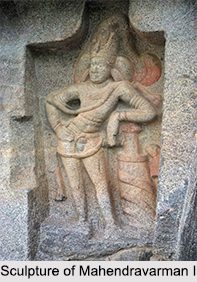 One of the greatest of the rulers of the Pallava dynasty Mahendravarman I Pallava, was a great warrior, administrator, playwright, artist, poet, musician and many more. Mahendravarman I Pallava was the Son of Simhavishnu, he ascended the Pallava throne in 600 A.D. His territory comprised of north Tamil Nadu and southern parts of Andhra Pradesh. In the thirty years of his rule, the Pallava kingdom, saw unparalleled activities of a unique nature in many spheres, the most important being the development of temple architecture.
One of the greatest of the rulers of the Pallava dynasty Mahendravarman I Pallava, was a great warrior, administrator, playwright, artist, poet, musician and many more. Mahendravarman I Pallava was the Son of Simhavishnu, he ascended the Pallava throne in 600 A.D. His territory comprised of north Tamil Nadu and southern parts of Andhra Pradesh. In the thirty years of his rule, the Pallava kingdom, saw unparalleled activities of a unique nature in many spheres, the most important being the development of temple architecture.
Mahendra was adequate warrior, however when Pulakesin II of the Chalukya dynasty of the ancient Karnataka area advanced upon Kanchipuram, the ancient capital of the Pallavas, Mahendra had to retreat to the gates of his city. With an artistic bent of mind, Mahendravarman was mostly preoccupied with peaceful governance and the betterment of education and the fine-arts. He was a fine Sanskrit scholar, his two excellent dramas Mattavilasa Prahasana and the Bhafjavatajjukam are studied with zest by Sanskrit scholars even today, approximately 1300 years after they were first composed.
With love for music Mahendravarman composed the inscription on music at Kudimiyamalai in Pudukottai district which is in Sanskrit and etched in the ancient Grantha script. This inscription consists of groups of musical notes arranged for the benefit of students by this king. This text is divided into seven sections, each of which is arranged in seven sub-sections each having 16 sets of four notes. Mahendravarman was found of painting and is said to have penned a treatise on south Indian paintings called Dakshinachitra, unfortunately it has been lost in the course of time.
Mahendra`s greatest contribution to the culture of the Tamil country was in the field of architecture. Realizing the need to build temples out of imperishable material, he launched on the experiment of excavating caves out of hard granite hills. Once these caves were excavated, supported by huge monolithic pillars, sculptures or paintings of Hindu deities were placed inside for worship. This was the very first time that such temples of hard rock were made in the Tamil land and this subsequently led to unprecedented architectural activity in this part of the country, unparalleled in the annals of Indian history.
There are many who believe that Mahendravarman was initially a Jain who was later converted to Saivism by the famous Saiva saint (Nayanmar) Appar who was his coeval. Mahendra was lucky to have his son and successor, Narasimhavarman I, an equally brave king who was likewise well disposed towards the fine arts and who ascended the throne on the death of his father.






































